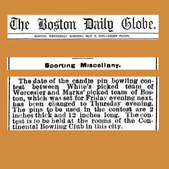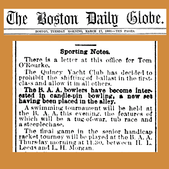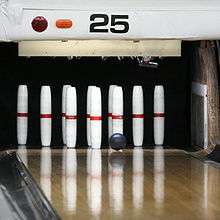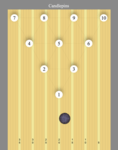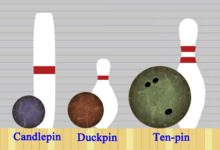Candlepin bowling
Candlepin bowling is a variation of bowling that is played primarily in the Canadian Maritime provinces and the New England states of the United States. It is played with a handheld-sized ball and tall, narrow pins that resemble candles, hence the name.
 Candlepin lanes at a bowling alley in Woburn, Massachusetts | |
| First played | Circa 1880, Massachusetts, U.S. |
|---|---|
| Characteristics | |
| Contact | No |
| Team members | Yes and individual |
| Mixed gender | Yes |
| Type | Bowling |
| Equipment | Candlepins, candlepin bowling ball, bowling lane |
| Venue | Bowling alley |
| Glossary | Glossary of bowling |
| Presence | |
| Country or region | New England, The Maritimes |
Comparison to ten-pin bowling
As in other forms of bowling, the players roll balls down a wooden lane to knock down as many pins as possible. The main differences between candlepin bowling and the predominant ten-pin bowling style are that 1) in candlepin bowling, each player uses three balls per frame, rather than two (see below); 2) the balls in candlepin are much smaller (11.43 cm or 4½ in diameter) with each ball weighing as much as only one candlepin and lack finger holes; 3) the pins are thinner (hence the name "candlepin"), and thus harder to knock down; and 4) the fallen pins (known as " dead wood") are not cleared away between balls during a frame. Because of these differences, scoring points is considerably more difficult than in ten-pin bowling.
Unlike in ten-pin bowling, the pinsetter is triggered manually with a reset button after each frame.
History

The International Candlepin Bowling Association (ICBA) website states that candlepin bowling was first played in 1880 in Worcester, Massachusetts,[5] thought to have been developed by Justin White, owner of a billiards and bowling hall.[6] A 1987 Sports Illustrated article stated the game was invented in 1881 in that town by one John J. Monsey, a billiards player,[7] who is recognized for standardizing the game.[6] In particular, in 1906 Monsey created the National Duckpin and Candlepin Congress, which regulated ball size, pin shape and size, and lane surface characteristics, facilitating formation of leagues and other competitions.[6]
Originally, pins were inch-thick dowels, resembling candles, thought to give rise to the name, candlepins.[7] An 1888 newspaper article referred to 2-inch thick pins.[1] Both were thinner than modern candlepins which are specified to be 2 15⁄16 inches thick.[8] In the late 1960s plastic candlepins began to replace wood candlepins, a change that some thought required a change in game strategy.[6]
In 1947, lawyers Howard Dowd and Lionel Barrow overcame the need for human pinsetters by inventing the first automatic candlepin pinsetter,[6] called the "Bowl-Mor", the two inventors receiving a patent that issued in 1956.[4]
Station WCVB (TV-5) aired candlepin bowling's first televised show from 1958 through 1996, and in 1964 The Boston Globe launched its own annual candlepin tournament.[6] In 1965 the World Candlepin Bowling Council (WCPC) began its Hall of Fame, inducting WCVB commentator Don Gillis in 1987.[6] In 1973 station WHDH (TV-7) began airing Candlepins for Cash, allowing contestants to earn a jackpot by rolling a strike.[6]
In 1986 the International Candlepin Bowling Association (ICBA) was formed.[6]
The highest sanctioned candlepin score is 245, achieved in 1984 (Ralph Semb, Erving, MA) and again on May 13, 2011 (Chris Sargent, Haverhill, MA).[9]
Game play
A candlepin bowling lane, almost identical to a tenpin bowling lane, has an approach area of 4.3 to 4.9 meters (14 to 16 ft) for the player to bowl from, and then the lane proper, a maple surface approximately 1.05 metres (41 inches) wide, bounded on either side by a gutter (or "channel", or trough.) The lane is separated from the approach by a "foul line" common to almost all bowling sports, which must not be crossed by players. At the far end of the lane are the pins, 60 ft (18 m) from the foul line to the center of the headpin (or pin #1), placed by a normally "manually"-triggered machine called a pinsetter which occupies space both above and behind the pins. Unlike a tenpin lane, which has a level surface all the way from the foul line end of the lane's approach to the back end of the lanebed's "pin deck", a candlepin lane has a hard-surfaced "pin plate" where the pins are set up, with the pin plate depressed 7⁄16 inch (11 mm) below the lanebed forward of it. The pin plate can be made from hard-surfaced metal, "phenolic", "high density plastic", or a "synthetic" material. Behind the pin plate area of a candlepin lane is a well-depressed "pit" area for the felled pins and balls to fall into. A heavy rubber backstop, faced with a black curtain, catches the flying pins and balls so they may drop into the pit. Generally there is seating behind the approach area for teammates, spectators, and score keeping.
The candlepins themselves are 15 3⁄4 inches (40 cm) tall, have a cylindrical shape which tapers equally towards each end (and therefore having no distinct "top" or "bottom" end, unlike a tenpin), giving them an overall appearance somewhat like that of a candle, and have a maximum weight of 2 lb 8 oz (1.1 kg) apiece.[10] Candlepin bowling uses the same numbering system and shape for the formation within the ten candlepins are set, as the tenpin sport does. Also, as in tenpin bowling, due to the spacing of the pins (12 inches or 30 centimetres, center to center), it is impossible for the ball to strike every one. However, while in tenpin a well-placed ball (usually between the head pin and the 2 or 3 pin) may knock down all ten pins (a "strike" if on the first ball in a frame) from the chain reaction of pin hitting pin, in candlepins the smaller thickness of the pins makes throwing a strike extremely difficult. In order to count, the pin must be knocked over entirely; in unlucky circumstances, a pin may wobble furiously, or, even more frustratingly, be "kicked" to the side by several inches, yet come to rest upright, thus not being scored (and not be reset to its original position for any throws that remain, though it may of course still be knocked over by subsequent balls). It is even possible for a toppled pin to bounce off a side "kickback", and return to a standing position on the lane's pin deck in the candlepin sport. However, in the event that a fallen pin returns to a standing position, the pin is still counted as fallen and is played as live wood.[10]
Height scale: horizontal blue lines in background are one inch apart.
In addition to the foul line for the bowler themselves, there is a line 10 feet (3.0 m) down the lane from the foul line; this is the lob line, and the ball must first contact the lane at any point on the bowler's side of it, be it on the approach or the first ten feet of the lanebed. Any "airborne" ball delivery not making contact with the approach or lanebed short of the "lob line" constitutes a violation of this rule, and is termed a lob with any pins knocked down by such a ball not counting — and such pins are not reset if the lobbed ball was not the third and last shot for that player in that box.
Also, a third line, centered 61 cm (24 in) forward of the head pin (number-1 pin) spot is the dead wood line, which defines the maximum forward limit that any toppled pins ("wood") can occupy and still be legally playable ("live wood"). This lane specification essentially results in the presence of three foul lines, more than in any other bowling sport.
The ball used in candlepins has a maximum weight of 2 lb 7 oz (1.1 kg), and has a diameter of 4.5 in (11 cm),[8] making it the smallest bowling ball of any North American bowling sport. The nearly identical weight of the ball, when compared to that of just one candlepin 2 lb 8 oz (1.1 kg),[8] causes balls to deflect when impacting either standing or downed pins.
A game of candlepin bowling, often called a string in New England, is divided into ten rounds, each of these rounds being most commonly referred to as a box, rather than a "frame" as in tenpin bowling. In each normal box, a player is given up to three opportunities to knock down as many pins as possible. In the final box, three balls are rolled regardless of the pincount, meaning three strikes can be scored in the 10th box.
One unique feature of the candlepin sport is that fallen pins, called wood, are not removed from the pin deck area between balls, unlike either the tenpin or duckpin bowling sports. The bowler, according to the rules of the sport—before delivering the second or third ball of a box—must also wait until all of the wood on the deck comes to a rest. Depending on where the fallen pins are located on the pindeck and their angle(s) after all movement of them ceases, the wood can be a major help, or obstacle—partly due to the ball having nearly the same weight as one candlepin—in trying to knock down every single standing pin for either a spare or "ten-box" score in completing a round.
In each of the first nine boxes, play proceeds as follows: The first player bowls his first ball at the pins. The pins he knocks down are counted and scored. Then the player rolls a second and a third ball at any remaining targets. If all ten pins are knocked down with the first ball (a strike), the player receives ten points plus the count on the next two rolls, the pins are cleared, a new set placed. If all ten pins are knocked down with two balls (a spare), the player receives 10 points plus the count of the next ball, pins are cleared and reset. If all three balls are needed to knock all the pins down, the score for that frame is simply ten, and known in New England as a ten-box. If more than one player is playing on the same lane at the same time, bowlers will typically roll two complete boxes before yielding the lane to the next bowler.
In the tenth box, play is similar, except that a player scoring a strike is granted two additional balls, scoring a spare earns one additional ball. Three balls are rolled in the tenth box regardless.[11]
In league play, a bowler may roll two or five boxes at a time, depending on the rules of the league. The five box format is sometimes called a "speed league," and this format is also typical for tournament play. When a bowler is rolling blocks of five boxes, each period is typically called a "half."
Fouls
A foul (scored by an F on some computer scoring systems) refers to a ball that first rolls into the gutter and then strikes deadwood (felled pins resting in the gutter) or hops out of the gutter and strikes a standing pin, a "lob"-bed ball that touches neither the approach, nor lane in the three meters' distance of lanebed before the lob line, or as in tenpins and duckpins, a roll made by a bowler's foot crossing over the foot foul line shared by nearly all bowling sports. Special scoring comes into play.
A foul always scores zero (0) pinfall for that ball's delivery. A player may reset the pins after a foul on the first or second ball provided no pins have legally been felled in that box. Therefore, if on the first ball there is a foul or zero, and on the second ball the bowler fouls and knocks down pins, the pins may be reset, allowing the bowler an opportunity to score a ten box on their third ball. Knocking down all ten pins after resetting immediately following a foul in the first ball results in a spare. Fouling on all three attempts scores a zero box.
If the first ball knocked down at least one pin, the rack can not be reset because of a subsequent foul. Those pins felled by a foul ball (a ball rolled into the gutter, a lobbed ball, a ball delivered by a bowler over the foot foul line)—whether standing, playable wood, or pins in the gutter—remain down and reduce the maximum number of pins to be counted for the box. Therefore, if there are six pins standing after the first ball, a foul on the next ball that manages to knock down the remaining six pins means that the frame is finished, with a score of 4. However, if the foul ball knocked down only some of the six standing pins, a third ball may still be rolled to attempt to knock down the remaining upright pins. In this example, the raw score might appear to be "4 4 2 = X", but after adjusting for the foul second ball, the true score is "4 F 2 = 6". Similar logic holds when rolling two good balls and fouling in the third attempt: the frame is over and only the pins felled in the first two attempts are recorded for the score for that box.[10]
While some candlepin alleys have automated scoring systems, and thus know when to trigger a candlepin pinsetter to clear and reset pins; other alleys, especially older ones that require a manual method to initiate the pinsetter will have a button, or floor-mounted foot pedal switch, to start the pinsetter's electrically-powered clearing and resetting of pins. Before the era of the Bowl-Mor powered pinsetter units' debut in 1949,[12] as with ten-pin, candlepins were set by workers called "pinboys".
Scoring
One point is scored for each pin that is knocked over. So, in a hypothetical game, if player A felled 3 pins with their first ball, then 5 with their second, and 1 with the third, they would receive a total of 9 points for that box. If player B knocks down 9 pins with their first shot, but misses with their second and third, they would also score 9.
In the event that all ten pins are felled by any one player in a single box, by no more than two throws (just as in tenpins) bonuses are awarded for a strike or spare. A strike is achieved with just the first delivery downing all ten pins, with a spare needing two throws, again just as in the tenpin sport. If all ten pins are felled by rolling all three balls in a box, the result is a derby, marked by an X (as in the Roman numeral for ten) but no additional points are awarded. (In tenpin bowling, a strike is often scored with an X).
The maximum score in a game is 300. This is scored by bowling 12 strikes: one in each box, and a strike with both bonus balls in the 10th box. In this way, each box will score 30 points (see above: scoring: strike).
This scoring system, except for the scoring sheet's appearance and the graphic symbols used to record strikes, spares and 10-boxes,[13] is identical to that of duckpins, as it is the other major form of bowling that uses three balls per frame.
Scoring sheet

The candlepin scoring sheet is different from either tenpins or duckpins, in that it is usually oriented vertically, with two columns of squares in a two-square-wide, ten-square-tall arrangement to score one string for one player. The left-hand column is used to detail the "per-box" score, with the cumulative total being recorded down the sheet as each box is rolled in the right-hand column of squares, in a top-down order from the first box to the tenth.
Spares and strikes are also marked uniquely in candlepins. Spares are recorded in a box by coloring in the left upper corner of the appropriate left-hand square (using a triangular shape to "fill-in the corner"). If a strike is recorded, opposing corners of the left-hand square are similarly colored in, while leaving sufficient space between the "filled-in" opposing corners, to record the score from the two succeeding balls' "fill" total for the strike. A common (albeit unofficial) practice is to mark a strike on a strike's bonus ball (double strike) by shading in the remaining two corners of the first strike.
Calculating scores
Correct calculation of bonus points can be a bit tricky, especially when combinations of strikes and spares come in successive boxes. In modern times, however, this has been overcome with automated scoring systems. When a scoring system is "automated", the bowler only has to bowl. It keeps score and will reset the pinsetter after three balls are thrown or all 10 pins have been knocked down. If a scoring system is "semiautomated", the bowler has to enter the score but the computer will keep track of it. The bowler needs to press a button at the end of the ball return to receive a new "rack" of pins.
Jargon
Candlepin bowling uses its own colorful jargon to refer to the many scenarios that can arise in a game, with most of the terms denoting different combinations of pins left standing after the first ball has been rolled. Examples of these terms include:[14]
- Head pin: The 1-pin, which is in front of the other pins.[14]
- King pin: The 5-pin, which is in the center of the pins, and directly behind the head pin.[14]
- Wood: The fallen pins lying between the standing pins, often strategically used to knock down multiple standing pins which can be far apart.
- Deadwood: Fallen pins lying in the gutter, or on the lane either touching, or to the bowler's side of the Deadwood Line. Deadwood on the lane must be removed before the bowler may roll their next ball, while Deadwood in the gutter is left in place. If a delivered ball should strike any Deadwood prior to hitting any wood or standing pins on the lane, then that ball is considered "dead" and any pins felled by it do not count to the bowler's score.
- Mark: Spare or strike.
- Four Horsemen: Four pins in a diagonal line, from the head-pin outward;[14] if the 1–2–4–7, it is known as "Four horsemen, left side," and if the 1–3–6–10, it is known as "Four horsemen, right side." The usual tenpin term for a spare leave of this kind is a "picket fence" (used for a different spare leave in candlepins) or "clothesline".
- Spread Eagle: A split configuration consisting of the 2–3–4–6–7–10, caused by the first shot striking the head pin too directly, leading to a failure to scatter the pins.[14] Video of the "spread eagle" being left, then converted
- Diamond: Four pins that form a diamond-shaped configuration,[14] either the 2–4–5–8, known as "left-side diamond," the 3–5–6–9, known as "right-side diamond", or the 1–2–3–5, known as the "center diamond" (this same configuration, for any of the three configurations mentioned, is usually referred to as a "bucket" in standard ten-pin bowling, and while it is very difficult to convert into a spare in candlepin bowling, in ten-pin bowling a spare is usually made from it by an experienced bowler).
- Half Worcester: Perhaps the most distinctive term used in the game. This results when the first shot strikes either the 2-pin or 3-pin too directly, and knocks down (or punches out) only that pin and the one immediately behind it;[14] when only the 2- and 8-pins fall it is a "Half Worcester Left", and when only the 3- and 9-pins fall it is a "Half Worcester Right". According to legend, the term was coined when a team from Worcester and a team from Boston were competing in the semifinal round of a statewide tournament held sometime in the 1940s; late in the last match of the round, needing a mark, one of the bowlers on the Worcester team "punched out" only two such pins with his first ball, prompting a member of the Boston team to taunt him by saying, "You're halfway back to Worcester!"[15] It is sometimes said that a player will get "one a game" referring to the Half Worcester.
- Full Worcester: Knocking down 2–3–8–9, or two Half Worcesters.
- Quarter Worcester: Another term derived from the Half Worcester, knocking down half as many pins—either just the 2-pin or just the 3-pin.
- Triple: A three-game series. When spoken, it follows a rough total of the series, such as "500-triple," meaning the bowler rolled 500 or more for three games. Triple can also refer to three consecutive Strikes rolled by a bowler – other forms of Bowling would call this a "Turkey".
Television broadcasts
From 1958 until 1996, a weekly professional bowling match was produced by Boston television station WHDH-TV/WCVB-TV (channel 5), airing every Saturday morning, called Candlepin Bowling. The winner of this match would return the following Saturday to face a new opponent determined by the outcome of qualifying matches, or "roll-offs", held during the week. The program was hosted by sports announcers Jim Britt and Don Gillis. Cash prizes were awarded to both the winner and loser of the televised match, with bonuses for rolling three consecutive marks (strikes or spares in any combination, or a larger bonus for three strikes in a row), and for rolling a cumulative score of 400 or higher in the three games, or "strings", of which each match consisted. The highest series achieved in the history of the show was a 500-triple by Paul Berger, in 1992. The bowler was given an additional cash prize for reaching 500. For most of the year, this competition was restricted to men only, with a few weeks devoted to matches for women only; other televised matches were also held, involving mixed doubles teams of one male and one female bowler.
There is also a show that originates from the 1–7–10 Sportscenter in Augusta, Maine. It is on Spectrum channel 9 and is shown every Sunday night at 7 p.m. This show has been on air since 1997.
The ATV network in Atlantic Canada also aired a weekly, Saturday afternoon candlepin bowling show from September 12, 1986 to September 4, 1993, matching bowlers from New Brunswick against those from Nova Scotia. Its sponsors were the Number 7 (1986–1988), Mark 10 (1988–1990), and Belvedere (1990–1993) cigarette companies.
Notable candlepin bowling broadcasts
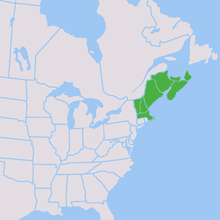
Each show is listed with its station of origin
- Hosted by Jim Britt (1958–61) and Don Gillis (1961–96)
Candlepin Bowling was the first candlepin bowling show to be broadcast on television. When WHDH lost its broadcast license, the show simply moved to the new channel 5, WCVB. Originally taped at the former Boylston Bowladrome (1260 Boylston Street, Boston), then at Sammy White's Brighton Bowl, the show moved to the Fairway Lanes (demolished in 2011) in Natick (where Candlepin Doubles was already taping) when Sammy White's closed down in 1986. From 1976 to 1995, there were a total of 20 candlepin championship shows that were broadcast live at the end of every season with the top bowlers with the top scores posted during the regular season of Candlepin Bowling. The first seven pitted the top two bowlers in a three string championship final, and then starting in 1983, the top five bowlers competed to take home $10,000 for first place. The first ten were at Sammy White's from 1976 to 1985, then at Fairway Lanes from 1986 to 1987, and from 1988 to 1995 at Pilgrim Lanes in Haverhill, Massachusetts. Candlepin Bowling was canceled in 1996 due to WCVB's lessened interest in the broadcasting of local shows. WCVB was also more interested in the broadcasting of Boston College football games. During the 1980s and 1990s, this program was also locally syndicated to WGGB-TV Channel 40 in Springfield, Massachusetts and WPRI-TV Channel 12 in Providence, Rhode Island.[17] In the late 1970s through 1985, the show used Van McCoy's disco dance hit The Hustle as its theme song.
- Winning Pins—WHDH-TV, Channel 5, 1961–74
- Hosted by Jim Britt
A children's version of Candlepin Bowling, showcasing the best bowlers under 16 years of age. Taped at Sammy White's Brighton Bowl.
- Candlepin Champs—WHDH-TV, Channel 7, 1970s
- Hosted by Dana Hersey.
A youth bowling show taped on two candlepin lanes in the Channel 7 parking garage in Boston. Each program consisted of two 2-string matches, one boys' and one girls' match, in one of two age groups (junior/senior).
- Bay State Bowling—WUNI-TV, Channel 27, 1970–82
- Hosted by Bob Fouracre and Dave Adams
WSMW-TV (Channel 27) in Worcester first aired in 1970. This was one of WSMW's inaugural shows when the station first went on the air. The format was similar to Channel 5's Candlepin Bowling. This show was notable for its use of the 1972 pop hit Roundabout by the British band Yes, as well as the 1975–1981 animated opening theme to the tune of The Spinners' Rubberband Man. This show, and all of WSMW's other programming, got cancelled in late 1982 when the station's pay-TV movie block expanded to a 24/7 schedule. Taped at State Mutual Life Assurance Co. (now Hanover Insurance), Worcester, MA, until 1979, then at Thunderbird Bowl in Auburn.
- Candlepin Superbowl—WCVB-TV, Channel 5, 1972–83
- Hosted by Bill O'Connell (1972–82) and Brian Leary (1982–83)
Candlepin Superbowl was a mixed doubles show. Premiering soon after WCVB took over the Channel 5 band, the Superbowl pitted two teams made up of one male and one female bowler each. Taped at Sammy White's Brighton Bowl.
- Candlepins for Cash—WNAC, Channel 7, 1973–80 and WXNE, Channel 25, 1980–82
- Hosted by Bob Gamere (WNAC) and Rico Petrocelli (WXNE)
Candlepins for Cash, being Boston's regional version of Claster Television's Bowling for Dollars franchise, devolved from a competitive nature to more of a game show format. Bowlers were introduced one by one to win money and prizes by how well they did on the lanes. Also featured a special "red pin" which was worth extra cash if felled on a strike. WNAC taped the show in studio on lanes built specially for the show (there were two lanes in the studio alley). When WNAC chose not to renew the show in April 1980, production moved that fall to WXNE, Channel 25, which taped the show at an actual bowling alley, the Wal-Lex Lanes in Waltham, Massachusetts. Host Bob Gamere stayed on for a while after the station switch, but after he left, WXNE hired former Boston Red Sox star Rico Petrocelli as the new host.
- Candlepin Doubles—WCVB-TV, Channel 5, 1983–93
- Hosted by Brian Leary (1983–88), Ed Harding (1988–93).
Candlepin Doubles was a revamped version of Candlepin Superbowl, focusing primarily on all-male and all-female matches, as compared to Super Bowl's mixed doubles format. Taped at Fairway Lanes in Natick.
- Big Shot Bowling—New England Sports Network, 1985–1991
- Hosted by Bob Fouracre and Dan Murphy
NESN's entry into the televised bowling market was similar in format to Channel 5's Candlepin Bowling, however qualifying requirements were more strict than Channel 5, with intentions to attract the best bowlers in the New England area. Taped at the Londonderry Bowling Center in Londonderry, New Hampshire.
- Candlepin Stars and Strikes—WWJE-DT, Channel 50, 1983–2005
- Hosted by Doug Brown, Dan Murphy (older versions of the show) Dick Lutsk and Mike Morin (most recent versions of the show)
Similar in format to the Channel 5 show, except in a stepladder format. Starting during the 1988–89 season, each ladder winner qualified for the Tournament of Champions at the end of the season, which was in the same format as the regular season stepladders. Taped at Park Place Lanes in Windham, New Hampshire from 1984 to 1997, and then at Leda Lanes in Nashua, New Hampshire from 1997 to 2005.
- Candlepin Bowling—1980s–90s
Originated in Lewiston, Maine, and aired in the Portland, Maine, television market on Sunday mornings in the 1980s and 1990s. Sponsored by La-Z-Boy furniture, the show was famous for its two hosts being seated in recliner-rockers for the event, including cutaway shots of the hosts.
- Stars and Strikes Doubles—WWJE-DT, 1991–94
- Hosted by Doug Brown and Dan Murphy
Similar to the singles show, each team pitted two candlepin bowlers with winners qualifying for the Tournament of Champions at the end of the season. Taped at Park Place Lanes during the 1991–92 season, and then at the Londonderry Bowling Center the next two seasons.
- Candlepin Skins—WWJE-DT, 1994–97
- Hosted by Doug Brown and Dan Murphy
This format features four bowlers, two champions and two challengers, competing for "skins" prize money. The four bowlers bowled two strings, and the bowler with the high score each frame won the amount the box was worth. If two, three, or four bowlers tied each frame, the money got carried over to the next frame. The two bowlers with the highest total pinfall moved on to the next show the next week to challenge two other bowlers. During the 1994–95 and 1995–96 seasons, the show was taped at the Londonderry Bowling Center and there was a total of $400 in prize money up for grabs. The first three boxes each game were worth $10, the next three $15, the next three $25, and the 10th box was worth $50. During the 1996–97 season, the show was at Pilgrim Lanes in Haverhill, Massachusetts. The prize money increased to $600 per show. The first three boxes were worth $20, the next three $25, the next three $30, and the 10th box every game worth $75. Shows were at 12 noon Saturdays on WNDS, followed by 12 noon Sundays with Candlepin Stars and Strikes.
- Candlepin Action—Adelphia Communications Corporation Channel 9, (Augusta, Maine)—1997–(unknown)
Similar in format to the original Channel 5 show. Taped at the 1–7–10 Sportscenter in Augusta, Maine. Adelphia was sold to Time Warner Cable in 2005, and the program no longer appears on the local TWC-TV channel. It is not currently known when either Adelphia or Time Warner cancelled the show.[18]
- Candlepin Challenge—Comcast SportsNet New England, 2001–09
- Hosted by John Holt, Dan Murphy, and Trina Fernandez
Candlepin Challenge has three bowlers compete against each other, rather than two. Two bowlers compete for one string in the qualifying round, then the winner of that round plays two strings against a third bowler. The overall winner of the second round is declared that week's champion. At the end of each season, the top three bowlers of the season compete in a similar format but with a higher prize than the regular shows. Taped at the Woburn Bowladrome. For its first five seasons on AT&T Cable, the show was called The $30,000 Candlepin Challenge; it was renamed prior to its sixth season after Comcast bought AT&T Cable, though until 2008, the now-former station ID of CN8 was part of the name. Due to the closing of CN8 by Comcast, this show moved to Comcast SportsNet New England in January 2009. At the end of that season, production ceased due to lack of money and sponsors.
In literature
In The New York Times, reviewer Cathleen Schine called Elizabeth McCracken's 2019 novel Bowlaway "a history of New England’s candlepin bowling", the sport serving as "the novel’s unlikely, crashing, arrhythmic leitmotif".[19]
See also
- Stasia Czernicki (1922–1993)
References
- "Sporting Miscellany". The Boston Daily Globe. May 9, 1888. p. 5. Archived from the original on May 27, 2019.
- "Candle-Pin Bowlers". The Boston Daily Globe. March 8, 1889. p. 5. Archived from the original on May 28, 2019.
- "Sporting Notes". The Boston Daily Globe. March 17, 1891. p. 7. Archived from the original on May 28, 2019.
- U.S. Patent 2,757,000, Dowd, Howard M. and Barrows, Royal L., "Bowling Pin-Setting Mechanism", issued July 31, 1956
- "Candlepin Bowling History". Candlepin.org. International Candlepin Bowling Association. Archived from the original on May 9, 2019. Retrieved May 9, 2019.
- Eaton, Perry (August 6, 2015). "A year-by-year history of candlepin bowling". Boston.com. Boston Globe Media Partners, LLC. Archived from the original on August 8, 2016.
- Campbell, Douglas (December 7, 1987). "The Leading Light of Candlepin Bowling". Sports Illustrated. Archived from the original on March 28, 2016.
- New Hampshire Candlepin Bowling Association (2013). "Candlepin Bowling Rules / Pin specifications and ~ / Ball specifications". Archived from the original on January 26, 2016.
- "Haverhill man matches candlepin bowling world record". The Herald News. Fall River, Massachusetts. May 18, 2011. Archived from the original on 2019-02-07.
- International Candlepin Bowling Association (June 2010). "Candlepin Bowling Rules". Retrieved 3 December 2014.
- International Candlepin Bowling Association. "Candlepin Bowling Scoring Rules". Retrieved 3 December 2014.
- Patent for the Bowl-Mor candlepin machine
- "Massachusetts Bowling Association — How to Score" (PDF). www.masscandlepin.com. Massachusetts Bowling Association. Retrieved 3 December 2014.
- International Candlepin Bowling Association. "Candlepin Language". Retrieved 3 December 2014.
- Klaft, Lynne (7 April 2007). "On a roll". Worcester Telegram & Gazette. Worcester, MA.
- "Find a center". Candlepin.org. International Candlepin Bowling Association (ICBA). Archived from the original on May 15, 2019. Retrieved May 14, 2019. Interactive map through MapMaker.com. See also Google maps.
- "Channel 5 television show information". Archived from the original on 2010-12-12. Retrieved 28 October 2014.
- TWC-TV Schedule for the Augusta, ME area as of 11/18/2008
- Schine, Cathleen (February 12, 2019). "A Dark Fairy Tale of American Oddballs and Candlepin Bowling". The New York Times. Archived from the original on April 11, 2019.
External links
- International Candlepin Bowling Association
- Eaton, Perry (August 6, 2015). "A year-by-year history of candlepin bowling". Boston.com. Boston Globe Media Partners, LLC. Archived from the original on August 8, 2016.
- Map showing locations of Candlepin, Duckpin, 5 Pin and 9 Pin Centers of North America
